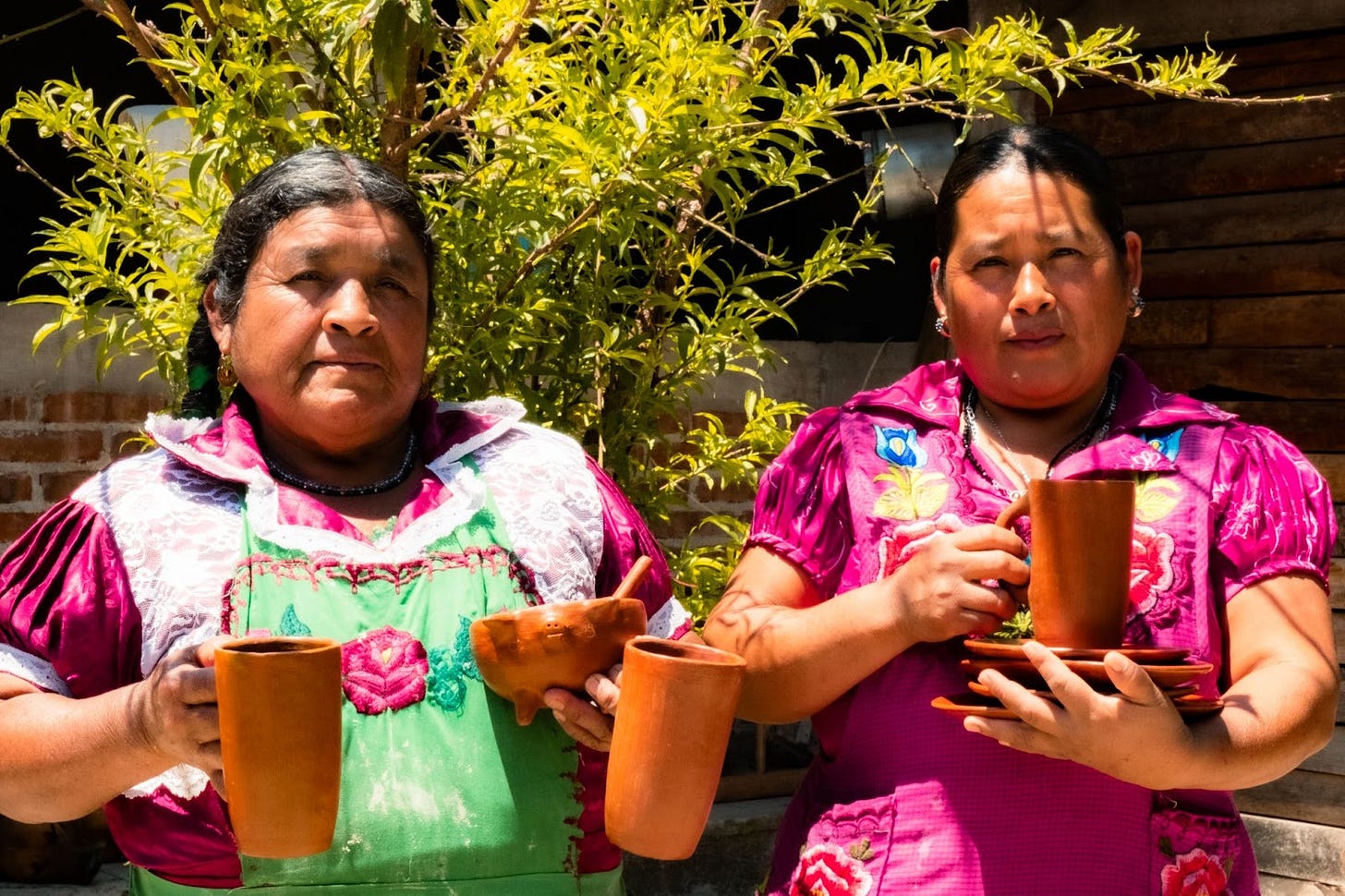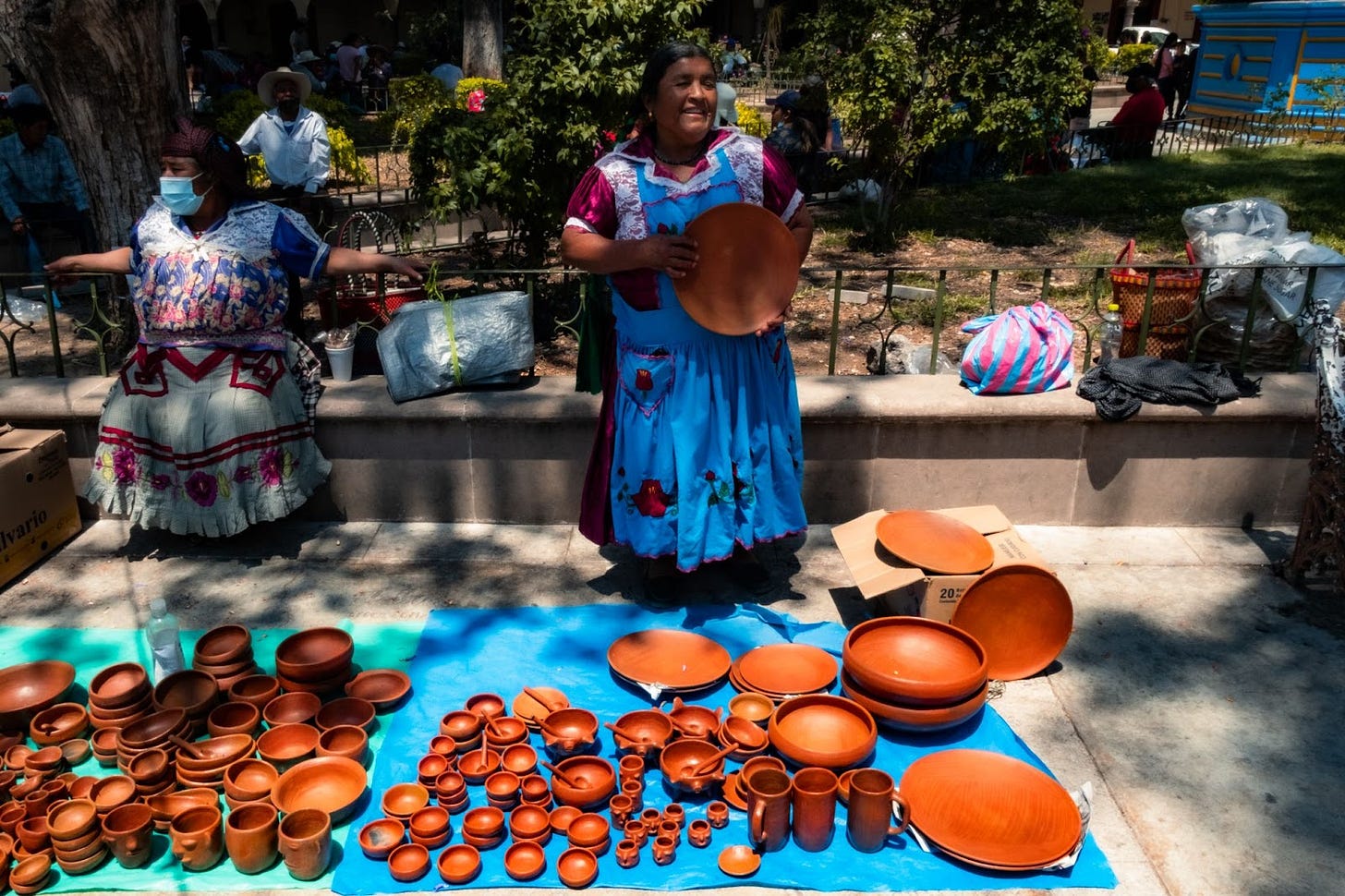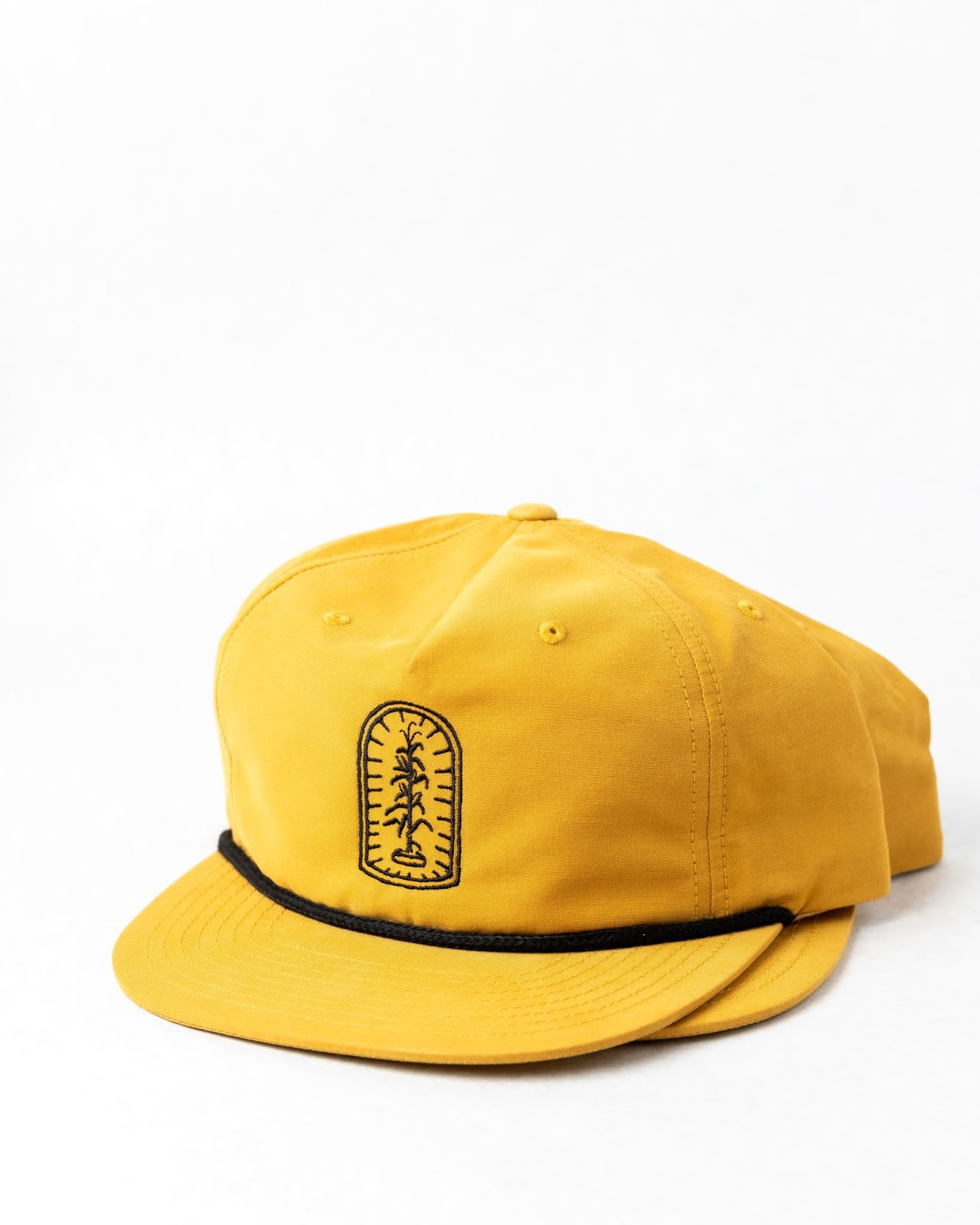Angela & Dominga in San Marcos Tlapazola
Another snapshot into Chef Pedro’s world.
Conversation with Shelley Kleyn Armistead, Chef Pedro Aquino’s Mother Angela Aragón Cruz and Sister Dominga Aquino Aragón, Facilitated by Translator Santiago Reyes
Introduction by Shelley Kleyn Armistead

I first met Chef Pedro’s mother and sister about five years ago at his mother’s house. I had checked in on them as I was driving through the village of San Marcos Tlapazola. There was this beautiful photo of Pedro as a young boy approximately 11 or 12 years old, but nothing more recent. It struck me how many parents had no recent printed images of these incredible humans they had created, and so since then I never visit without printed photos for the families. It was at this visit that we first explored the conversation of ceramics for Chef Pedro’s kitchen. Even when Pedro was Head Chef of MTN, we were exploring bringing this piece of Oaxaca into his work space. Four years ago I had taken a special plate that I knew Pedro loved plating on as a shape for something I hadn’t yet seen throughout the villages. I had only shared this shape with his family, as I thought there are no better people to create his favorite plate than his mother and sister, using the earth he grew up on. For four years that plate has been waiting for the right time. The years in between have allowed Pedro to develop Valle with Chef Juan, and order his mothers tortillas, which travel weekly to us in Venice. As Valle is under construction, Angela’s tortillas can be found in Gjusta Grocer. And as for that special plate, we cannot wait to showcase it, and more of Angela and Dominga’s ceramics soon. Until then, here is more on those tortillas and another snapshot into Chef Pedro’s world.
Angela recounts not going to school as a child, learning Zapotec from her mother, and making tortillas from the age of eight. Video by Santiago Reyes
Shelley Kleyn Armistead: How does Angela prepare her tortillas? What does she put on them?
Translator Santiago Reyes: For herself, just cheese, lettuce.
What are the foods Pedro liked most growing up?
Pedro liked to eat a lot. Almost everything they ate here, he liked. He ate avocado, mashed beans with cheese. He didn’t like meat. He really liked beans.
Video by Santiago Reyes
Pedro is interested in knowing what Tlapazola needs. I know he is passionate about sports and the kids having access to sports. What do they think the needs are?
There are no classes, and the children are suffering. For example, Dominga’s daughter… vacation just started, but the children are only going two days a week, and that’s nothing for them. They should be going every day. The parents are worrying.
The school is in Tlapazola? And what age does the school go to?
From six to 12.
So what do they do when they're 12? They have to go to Tlacolula?
There's something called, like, "TV mirror school" — that's like a direct translation — it's very famous in Mexico. And they just have classes....
Online?
It's not online. It's like cable, like cable TV. So we just have, like a television, teaching them.
If Tlapazola had a teacher that could teach until 12th grade, or age 18, do you think there's a place for them to do that here?
They would have a place that is the place they go to have children classes already, they could use that place, but she's also mentioning that the parents' committee has to be spoken about.
It has to be approved?
It has to be approved.
Is there a reason why they wouldn't have a teacher until 18? Do they know?
So they do have three teachers that go to the school to teach, but right now at this point, they're not going every day because of the pandemic and also there are times in which the teachers… they just don't show up.
Right. How many children do you think there are in Tlapazola?
From first grade to sixth grade, it's only fifty two kids. Dominga’s daughter is only 11 years old.
What will their kid do when they turn 12?
She's going to go to the TV school.
Tasajo asado, chiles de agua asados, and beef fat. Video by Santiago Reyes
Do they have any questions for me?
No, no. Angela just wants to see her son — it's been 17 years since she has seen him.
He really wants his children to spend time here learning.
They're saying they're going to teach Zapotec to them.
Good! Sí, sí, sí. Do they know where Delfino is? I have one person that works with Pedro. He asked me to give his father photos, but I don't know Delfino.
We can leave it here — they are primos, cousins.
Gracias. Delfino's son is Crispin, and Crispin works with Pedro.
They asked me how I knew English, and I told them my father taught me since I was very little, and she said it would be very good for children to learn English. And then I asked them if they had a teacher, and Dominga said that three Americans from Los Angeles are coming to teach.
Really? Does she know who it is? We need to find out who they are because we can also help.
They're from Los Angeles but they live in Oaxaca.
Ah, okay. But they'll still know Pedro's restaurants. They're very famous in Los Angeles.
He's telling me about how Pedro only went to second grade of school when he was growing up.
Yep. Now look at him.
He liked taking care of the cattle better.
Yes.
I want to see Angela and Dominga’s ceramics!
She's getting them.
[Looking at ceramics] Wow. So bonito. Oh, this is perfecto for Pedro for the restaurant.
This is for the salsas. Dominga makes them.
Sí, sí, sí. Pedro has been looking for this shape. This is the shape he wants. Nobody's making the shape he wants.
[Shelley explaining to her son] All it is, they dig the clay out of the earth, water and fire, that's it. Nothing else.
They're sending this box to San Francisco. They're sending 3000 pieces.
Oh, that's amazing.
These plates, they're raw still.
Yeah, they haven't been cooked fully.
In Pedro's new restaurant, he designed a logo with a milpa, aquí. This hat is for you.
And then he designed this Valle bandana. These are mountains for the valle, his restaurant's name is Valle. He did the constellation of the stars above Tlapazola, the mountains, and the milpa. Pedro made that.
And that's for Delfino. And then for Dominga and Angela, I have a — how do you say shop?
Tienda.
I have a tienda where we make cerámica and we make textiles?
Textiles.
We make cerámica, we make textiles, so this is from California. This apron —
— mandil —
— is for you, Dominga.
Dominga: Gracias.
And then the cerámica is for Angela, from California.
Angela: Gracias.
Dominga, uno más.
Tu servilleta, Dominga.
Dominga: Sí, gracias.
Do you want to eat anything? Tortilla with huevos, consomé, she's asking?











Coolio!